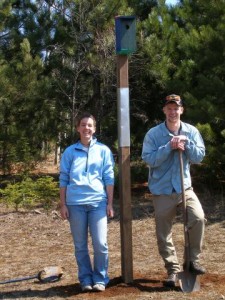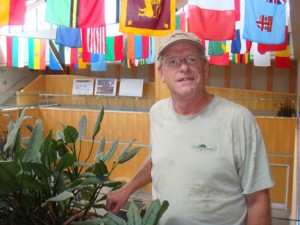
Associate Professor Andrew Burton is an author on a paper, “Soil-Warming Carbon-Nitrogen Interactions and Forest Carbon Budgets,” published in this week’s early online edition (May 23 to 27) of the Proceedings of the National Academy of Sciences (PNAS).
Burton is director of Michigan Tech’s Ecosystem Science Center and the Midwestern Regional Center for the US Department of Energy’s National Institute for Climatic Change Research. Lead author on the paper is Jerry Melillo of the Marine Biological Laboratory in Woods Hole, Mass. For more information, visit EurekAlert.
Copper Country Audubon recently installed six bird houses at the Calumet waste-water treatment ponds about a mile west of Calumet on Hwy M-203. Thanks go to Supervisor Ken Hyrkas and Foreman Tom Buckett for approval and advice where to put the bird houses. The treatment ponds area is a great place for birds; birdwatchers often go there to observe waterfowl and song birds.

Two bird houses were also installed at the Waasa Cemetery. The birdhouses, made by VSI/Goodwill Industries of Houghton, are on eight and ten foot posts. They may be used by tree swallows, bluebirds, wood peckers and flycatchers.
The Michigan Tech Wildlife Club from the School of Forest Resources and Environmental Science assisted in the activity. Copper Country Audubon thanks its many members that provided funds for the project. Thanks are also extended to the municipalities who allow use of their property to h
elp increase bird nesting success in the area. For more information about Copper Country Audubon contact President Dana Richter, dlrichte@mtu.edu, 487-2149.
View more photos: http://www.flickr.com/photos/mtufres/5737272849/in/photostream
Amber Roth was one of 12 nominees who were selected as the 2011 winners int he Notable Projects/Team Achievement category by the U.S. Department of the Interior, Fish and Wildlife Service. Amber was recognized for her work with Golden-winged Warbler Conservation in the Upper Midwest. Her work has contributed to landscape scale conservation not only in the Upper Midwest, but beyond. The project involves diverse agencies and institutions working together to achieve science-based conservation objectives and strategies.
Tom Stone was at the School in April conducting the Tree Farm Inspection Training. Tom is retired from the Michigan DNR and lives in Indian River, Michigan.
William Roehm, who attended Michigan Tech in Forestry in the early 1970s, visited the campus to show his son around. William now lives in Vista, California and is employed by the Oceanside Unified School District.
Stuart Kramer is an Americorps member teaching at an alternative school and running a Community Supported Agriculture (CSA) farm in Eugene, Oregon.
| Nearly 300 K-12 students from seven schools in Houghton, Baraga and Keweenaw counties ascended Brockway Mountain this spring, to view the annual raptor migration.
Research Engineer Dana Richter, forestry student Auriel Van De Laar, and members of the Copper Country Audubon Club helped students identify the raptors using binoculars, a spotting scope, and field guides–as well as learn about raptor characteristics and migration routes. Each spring, thousands of hawks, eagles and other raptors fly north along the Keweenaw Peninsula looking for a way to cross Lake Superior. As the birds reach the tip of the peninsula, some ride updrafts of warm air over Lake Superior, while others circle back and head for Duluth where they can follow the shoreline north. In April and May, people from all over the region visit this well-known scenic overlook for an, amazing view of raptors soaring by at eye level. Despite the popularity of the spring raptor migration among local and regional “birders,” few K-12 students have ever heard of the raptor migration. The Keweenaw Raptor Survey is a project of Copper Country Audubon and Laughing Whitefish Audubon of Marquette. Arthur Green (awg@gmx.us), a professional hawk-counter, is stationed on the mountain from March to June to count the raptors passing overhead. Sixteen species of raptors totaling almost 10,000 birds were counted in 2010. The 140 birds viewed on April 29 included: turkey vulture, osprey, bald eagle , northern harrier, sharp-shinned hawk, cooper’s hawk, northern goshawk, red-shouldered hawk, broad-winged hawk, red-tailed hawk, rough-legged hawk , golden American kestrel, merlin and peregrine falcon The staff of the Western UP Center for Science, Math and Environmental Education organized the event. For more information, visit: www.keweenawraptorsurvey.org . |


